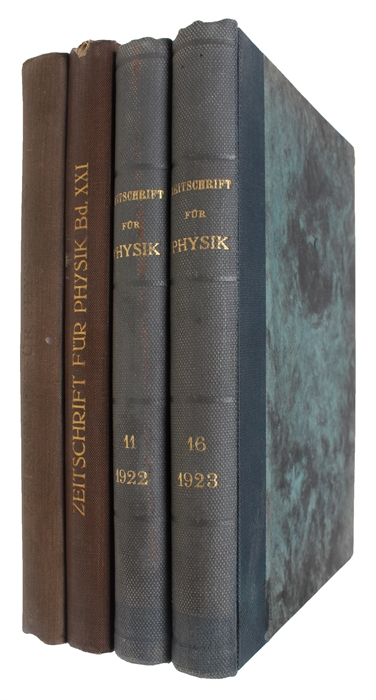THE CURVATURE OF SPACE
FRIEDMANN, ALEXANDER (+) ALBERT EINSTEIN.
Über die Krümmung des Raumes + Über die Möglichkeit einer Welt mit konstanter negativer Krümmung des Raumes [Friedman] (+) Bemerkung zu der Arbeit von A. Friedmann "Über die Krümmung des Raumes" (+) Notiz zu der Arbeit von A. Friedmann "Über die Krümmung des Raumes [Einstein].
Berlin, Julius Springer, 1922-24. 8vo. 4 contemporary half cloth binding: two in uniform half green cloth and two en uniform grey/blue half cloth. In "Zeitschrift für Physik", Bd. 10, 11, 16 & 21. Entire volumes offered. All volumes with stamp to title page and front free end paper, otherwise a fine and clean set. [Friedmann:] Bd. 10: Pp. 377-386; Bd. 21: P.p. 326-332. [Einstein:] Bd. 11:P. 326; Bd. 16: P. 228.
First printing of these four landmark paper in which Friedman "introduced into cosmology two concepts of revolutionary importance, the age og the world and the creation of the world" (Kragh, Cosmology and Controversy).
"In his paper of 1922, Friedmann offered a complete analysis of the solutions of Einstein's cosmological field equations that went beyond the earlier solutions of Einstein and de Sitter as it also included nonstatic solutions. Friedmann did so clearly and explicitly: "The purpose of this note," he wrote, "is firstly to show that the cylindrical [Einstein]and spherical [de Sitter] worlds are special cases of more general assumptions, and secondly to demonstrate the possibility of a world in which the curvature of space is independent of the three spatial coordinates but does on time".(Ibid.).
In 'Über die Krümmung des Raumes' Friedman derived the non-stationary solutions to Einstein's field equations. Einstein quickly responded in a short comment ('Bemerkung'), in which he expressed his suspicion of such a model of the Universe and apparently pointed out an error in Friedman's calculations. However, Friedman now wrote a letter to Einstein, in which he enclosed his full calculations. Shortly after this, Einstein submitted a short notice (Notiz), in which he admitted that he himself had performed a calculation error and that Friedman's solutions, which shed new light on the matter, were valid. Friedman's expanding universe model was corroborated by Edwin Hubble's red-shift observations in 1929.
In 'Über die Möglichkeit einer Welt mit konstanter negativer Krümmung des Raumes' Friedman derived the Friedman-equations and demonstrated that he had command of all three Friedman-models describing positive, zero and negative curvature respectively, nearly a decade before the independent discoveries of the same models by Lemaître, Robertson, and Walker.
"Friedmann made a valuable contribution to Einstein's general theory of relativity. As always, his interest was not limited simply to familiarizing himself with this new field of science but led to his own remarkable investigations. Friedmann's work on the theory of relativity dealt with one of its most difficult questions, the cosmological problem. In his paper "Über die Krümmung des Raumes" (1922), he outlined the fundamental ideas of his cosmology: the supposition concerning the homogeneity of the distribution of matter in space and the consequent homogence of "world" time for which, at any moment in time, the metrics of space will be identical at all points and in all directions. This theory is especially important because it leads to a sufficiently correct explanation of the fundamental phenomenon known as the "red shift." This solution of the Einstein field equations, obtained from the above propositions, is the model for any homogeneous and isotropic cosmological theory. It is interesting to note that Einstein thought that the cosmological solution to the equations of a field had to be static and had to lead to a closed model of the universe. Friedmann discarded both conditions and arrived at an independent solution. Einstein welcomed Friedmann's results because they showed the dispensability of the ad hoc cosmological term Einstein had been forced to introduce into the basic field equation of general relativity". (DSB).
Weil 122 & 130.
Order-nr.: 49429

